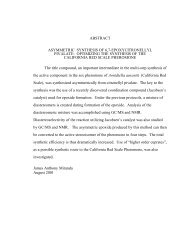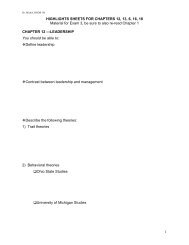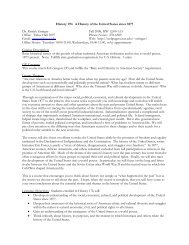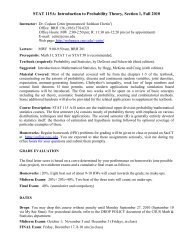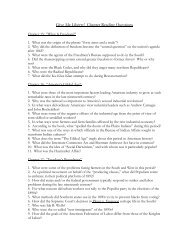I CHEMISTRY 25 Organic Chemistry Laboratory I Fall 2006 ...
I CHEMISTRY 25 Organic Chemistry Laboratory I Fall 2006 ...
I CHEMISTRY 25 Organic Chemistry Laboratory I Fall 2006 ...
You also want an ePaper? Increase the reach of your titles
YUMPU automatically turns print PDFs into web optimized ePapers that Google loves.
lab time without prior permission of all instructors affected by the scheduling change. Nomaterials, chemicals or supplies, may be removed from the lab without permission of theinstructor.Experiment Points: Your points for each experiment will be based on a completed pre-lab andpost-lab report sheet, spectral data, graphs and purity/quantitiy of chemicals synthesized in the labturned-in in a properly labeled vial (student name, compound name, experiment title, weight, mprange). The pre-lab reports are due at the beginning of each experiment while the post-lab reportsare due one week after the posted end date for that lab experiment. All lab reports are due at thebeginning of the laboratory period in which they are due. Late materials will be accepted onlywithin one week of the due date unless prior permission of the instructor is obtained, and latematerial will lose 10% of its assigned value with each day it is late.Exams: There will be two exams given. The first will be given half way through the courseduring the discussion hour, tentatively planned for the week of 10/30. There will also be an examgiven during finals week (see schedule below).Grading: Your grade for the course will be based on your experiment points, exams, yourlaboratory notebook, including a hazard table, and your laboratory technique throughout thecourse of the semester (see below for instructions on keeping a laboratory notebook).Lab book and technique 50Hazard Table 50Experimental points 550Exams (2) 300Total950 pts.Letter grades are assigned based on a range of: A to A- = 90.0% and above, B+ to B- = 89.9-80.0%, C+ to C- = 79.9-70.0%, D+ to D- = 69.9-60.0%, F = below 60.0%Cheating: Cheating in any form is not tolerated in this class. A student caught cheating willreceive a zero on that experiment/exam. If a student is caught a second time, the student will failthis course. Cheating includes: copying from another student's report (yes, even lab partners musthave their own unique answers), copying material or data from a previous report (your own orsomeone else's), turning in lab work done during a previous semester, reporting data for anexperiment you did not perform, using extra materials during testing, programming data into acalculator, having other people take tests for you, altering exams after they have been graded, etc.<strong>Laboratory</strong> Notebook: Read text pp. 8-22, 197-202. The correct notebook for the lab is ahardcover, bound notebook containing lined pages. A loose-leaf or spiral notebook is notsatisfactory because pages are easily removed and lost. A separate notebook should be used foreach laboratory course. If the pages are not numbered, number them before using the book.Make sure you write your name, address, and telephone number on the inside cover, in case it islost. Record your locker number and combination of your locker in your lab book or in someconvenient place. Leave two pages at the front of the lab book for a table of contents. Thenenter your experiments consecutively. All data will be recorded in permanent ink as it iscollected. NEVER ERASE IN A NOTEBOOK. If an error is made, ONE line is drawn throughthe mistake. DO NOT SCRATCH OUT ERRORS AND DO NOT RIP OUT PAGES FROMTHE LAB BOOK. Points will be deducted for illegible notebooks, however we do understandIII



